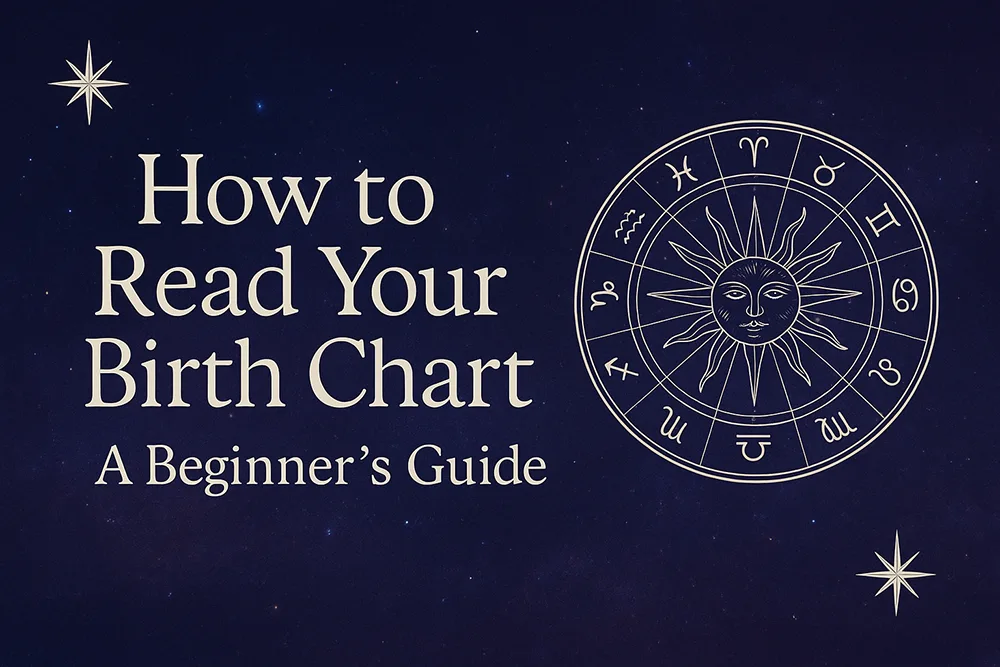Have you ever wondered why certain personality traits seem etched into your very being, or why life events unfold in patterns that feel almost predestined? In the fascinating world of astrology, your birth chart holds the key to unlocking these mysteries. Often referred to as a natal chart, this cosmic snapshot captures the positions of the planets at the exact moment of your birth, offering profound insights into your character, relationships, career, and life path. If you’re new to astrology and eager to learn how to read your birth chart, you’ve come to the right place. This comprehensive beginner’s guide will walk you through the essentials, demystifying the symbols, signs, and structures that make up this ancient tool for self-discovery.
Astrology has captivated humanity for millennia, blending astronomy with interpretive wisdom to help individuals navigate their inner and outer worlds. Whether you’re skeptical or already intrigued by your sun sign, diving deeper into your birth chart can reveal layers of your psyche that daily horoscopes barely scratch. By the end of this guide, you’ll have the foundational knowledge to interpret your own chart with confidence, empowering you to use astrology as a mirror for personal growth.
What is a Birth Chart in Astrology?
At its core, a birth chart is a personalized map of the heavens as they appeared from your birthplace at the precise time you entered the world. It’s not just about your zodiac sign—though that’s a starting point—but a complex diagram that incorporates planets, signs, houses, and aspects. Think of it as a blueprint of your soul’s potential, influenced by celestial energies that astrologers believe shape your destiny and free will.
To generate a birth chart, you’ll need three key pieces of information: your birth date, exact birth time (down to the minute if possible), and birthplace (city and country). This data allows astrology software or websites to calculate the positions of the sun, moon, planets, and other points in the sky relative to the Earth’s horizon. The result is a circular wheel divided into 12 sections, each representing different facets of life.
Why bother learning how to read your birth chart? For beginners, it provides a deeper understanding beyond generic sun sign descriptions. For instance, while you might know you’re a fiery Aries, your chart could reveal a sensitive Cancer moon that explains your emotional depth, or a practical Virgo rising that influences how others perceive you. Astrology enthusiasts often turn to birth charts during times of transition, such as career changes or relationship challenges, to gain clarity and guidance.
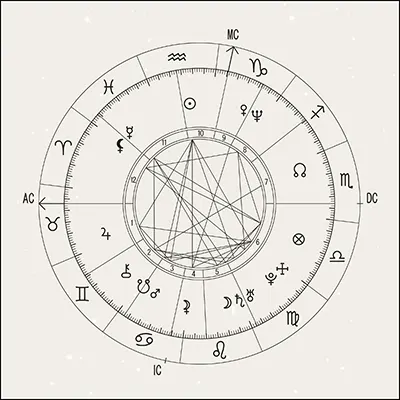
As seen in the example above, a birth chart looks like a wheel with symbols scattered throughout. Don’t be intimidated by the glyphs and lines—they each tell a story. We’ll break them down step by step in this guide.
How to Obtain Your Free Birth Chart
Before you can start reading your birth chart, you need to get one. Fortunately, in today’s digital age, accessing a free natal chart is easier than ever. Numerous online platforms offer instant chart calculations without requiring any payment or expertise.
Start with reputable websites like Astro.com, Cafe Astrology, or Astro-Seek. These sites have user-friendly interfaces where you input your birth details. For accuracy, double-check your birth time—it’s often listed on your birth certificate. If you don’t have the exact time, some charts can still be generated using a default (like noon), but this will affect the rising sign and house placements, which are time-sensitive.
Mobile apps such as Co-Star, The Pattern, or Sanctuary also provide birth charts with interpretive insights. Once generated, your chart will typically include a visual wheel, a list of planetary positions (e.g., Sun in Libra at 15 degrees), and sometimes basic explanations.
Pro tip for beginners: Print out your chart or save it as a PDF. Having a physical copy allows you to annotate as you learn, making the process of how to read your birth chart more interactive and memorable.
The Building Blocks: Zodiac Signs in Your Birth Chart
The zodiac signs form the foundation of any birth chart reading. There are 12 signs, each associated with an element (fire, earth, air, water) and a modality (cardinal, fixed, mutable). These signs color the energies of the planets placed within them, influencing how those planetary forces express in your life.
- Aries (Fire, Cardinal): Bold, pioneering, and impulsive. If your sun is in Aries, you’re a natural leader with high energy.
- Taurus (Earth, Fixed): Sensual, reliable, and stubborn. Taurus placements often indicate a love for stability and material comforts.
- Gemini (Air, Mutable): Curious, communicative, and adaptable. Geminis thrive on variety and intellectual stimulation.
- Cancer (Water, Cardinal): Nurturing, intuitive, and protective. Cancer influences bring emotional depth and a strong connection to home.
- Leo (Fire, Fixed): Charismatic, creative, and dramatic. Leos love the spotlight and express themselves with flair.
- Virgo (Earth, Mutable): Analytical, practical, and detail-oriented. Virgo energy focuses on service and self-improvement.
- Libra (Air, Cardinal): Harmonious, diplomatic, and social. Libras seek balance in relationships and aesthetics.
- Scorpio (Water, Fixed): Intense, transformative, and secretive. Scorpios delve into the depths of emotions and power.
- Sagittarius (Fire, Mutable): Adventurous, optimistic, and philosophical. Sagittarians crave freedom and exploration.
- Capricorn (Earth, Cardinal): Ambitious, disciplined, and responsible. Capricorns build structures for long-term success.
- Aquarius (Air, Fixed): Innovative, humanitarian, and eccentric. Aquarians value independence and progressive ideas.
- Pisces (Water, Mutable): Compassionate, imaginative, and spiritual. Pisceans are empathetic dreamers connected to the collective unconscious.
In your birth chart, every planet occupies a sign, modifying its core meaning. For example, a Mercury in Gemini enhances quick thinking and wit, while a Mercury in Pisces might make communication more poetic but less direct.

Refer to the zodiac wheel above to visualize how the signs progress in a counterclockwise manner, starting from Aries. Understanding these signs is crucial for beginners learning how to read a birth chart, as they provide the “flavor” to planetary placements.
Planets: The Actors in Your Astrological Drama
Planets are the dynamic forces in your birth chart, each representing different aspects of your personality and life experiences. In Western astrology, we consider 10 main planets (including the sun and moon, which are luminaries) and sometimes additional points like Chiron or the North Node.
- Sun: Your core identity, ego, and vitality. It rules your zodiac sign and shows where you shine brightest.
- Moon: Emotions, instincts, and inner needs. It governs your nurturing style and subconscious habits.
- Mercury: Communication, intellect, and learning. It influences how you think, speak, and process information.
- Venus: Love, beauty, and values. It reveals your approach to relationships, art, and pleasure.
- Mars: Action, drive, and passion. It shows your assertiveness, sexuality, and how you handle conflict.
- Jupiter: Expansion, luck, and wisdom. It brings opportunities for growth and optimism.
- Saturn: Discipline, structure, and lessons. It represents challenges that build character and responsibility.
- Uranus: Innovation, rebellion, and change. It sparks sudden insights and unconventional thinking.
- Neptune: Dreams, intuition, and spirituality. It connects to imagination but can also bring illusions.
- Pluto: Transformation, power, and rebirth. It deals with deep psychological changes and hidden truths.
Each planet’s symbol is unique, and in your chart, you’ll see them placed within signs and houses. For beginners, start by noting your “big three”: Sun, Moon, and Rising (Ascendant) signs, as they form the foundation of your personality.
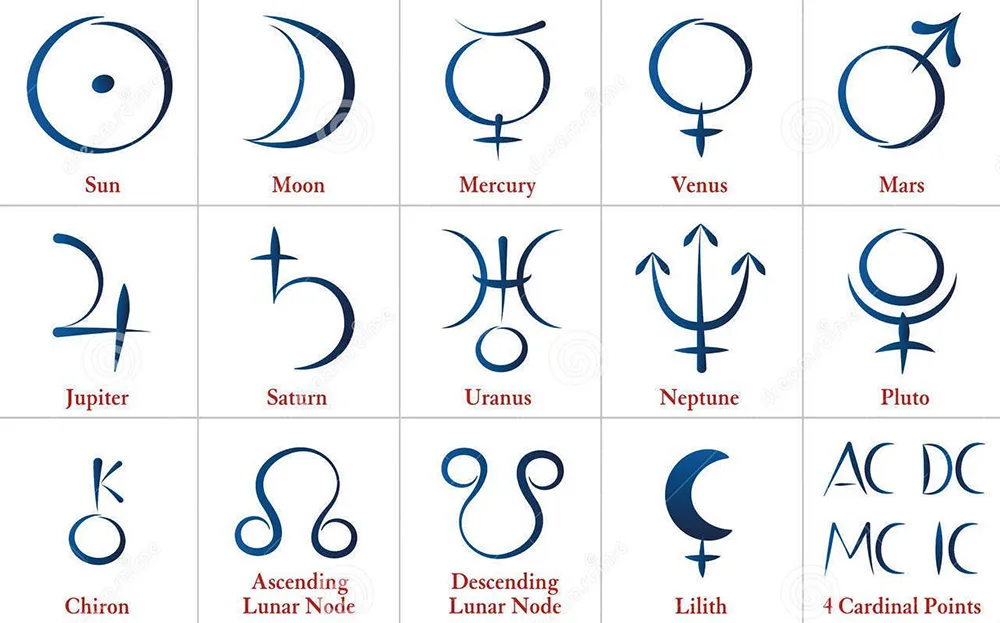
The planetary symbols above will help you identify them quickly on your chart. As you learn how to read your birth chart, pay attention to any planets in strong positions, like those near angles or in their ruling signs, for amplified effects.
Houses: The Stages of Life’s Play
The 12 houses in a birth chart divide the wheel into sectors, each governing specific areas of life. Unlike signs, which are fixed, houses are determined by your birth time and location, making them highly personal. The houses show “where” planetary energies play out.
- 1st House (Ascendant): Self, appearance, and first impressions. Your rising sign is here.
- 2nd House: Possessions, values, and self-worth. It relates to finances and material security.
- 3rd House: Communication, siblings, and short trips. It covers learning and local environment.
- 4th House (IC): Home, family, and roots. It delves into emotional foundations and ancestry.
- 5th House: Creativity, romance, and children. It’s about joy, self-expression, and fun.
- 6th House: Health, work, and daily routines. It focuses on service and habits.
- 7th House (Descendant): Partnerships, marriage, and others. It balances the self with relationships.
- 8th House: Transformation, intimacy, and shared resources. It involves sex, death, and rebirth.
- 9th House: Philosophy, travel, and higher education. It expands horizons through beliefs.
- 10th House (MC): Career, status, and public image. It’s your legacy and ambitions.
- 11th House: Friends, groups, and aspirations. It connects to community and hopes.
- 12th House: Subconscious, secrets, and spirituality. It deals with hidden strengths and karma.
Houses can be empty or contain multiple planets, but every house has a ruling sign and planet. For example, if Aries rules your 10th house, your career might involve leadership and initiative.
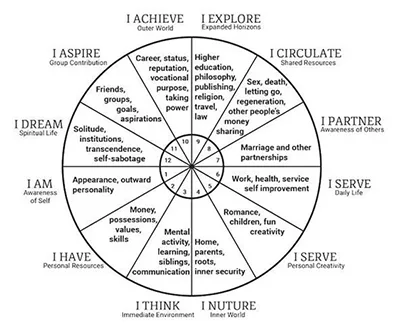
Use the house diagram above as a reference when examining your chart. Beginners often find houses the most revealing part of how to read a birth chart, as they pinpoint real-life applications.
Aspects: The Conversations Between Planets
Aspects are the angles between planets, indicating how they interact—harmoniously or challengingly. These lines on your chart (often color-coded: blue for easy, red for tense) add nuance to interpretations.
Major aspects include:
- Conjunction (0°): Planets blend energies intensely, amplifying each other.
- Sextile (60°): Supportive and opportunistic, fostering talent.
- Square (90°): Tension and conflict, driving growth through challenges.
- Trine (120°): Harmonious flow, indicating natural gifts.
- Opposition (180°): Polarities that require balance, often in relationships.
Minor aspects like quincunx (150°) or semi-sextile (30°) add subtlety. For instance, a sun square moon might create inner conflict between ego and emotions, while a Venus trine Jupiter could bring luck in love.
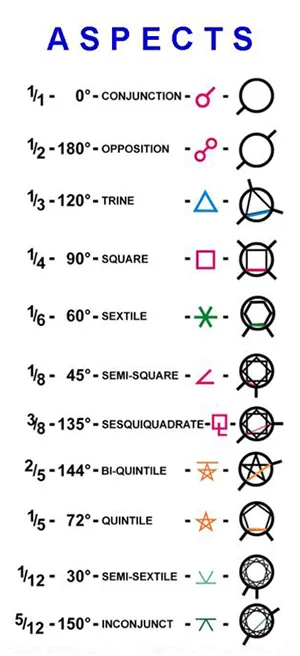
The aspects chart above lists common ones with their symbols. When learning how to read your birth chart, start with major aspects to avoid overwhelm.
Step-by-Step Guide to Interpreting Your Birth Chart
Now that you understand the components, let’s put it all together. Here’s a beginner-friendly, step-by-step process for reading your birth chart:
- Identify Your Big Three: Locate your Sun (core self), Moon (emotions), and Ascendant (outer self). For example, Sun in Scorpio, Moon in Aquarius, Rising in Capricorn suggests intensity tempered by detachment and ambition.
- Note Planetary Positions: List each planet’s sign and house. Mercury in the 3rd house in Gemini? You’re a natural communicator.
- Examine House Rulers: See which signs rule each house and where their ruling planets are placed. This reveals interconnections.
- Analyze Aspects: Look for patterns like stelliums (clusters of planets) or T-squares (tense configurations). These highlight strengths and challenges.
- Consider Elements and Modalities: Tally fire/earth/air/water and cardinal/fixed/mutable. Imbalances (e.g., lots of water) show dominant traits.
- Integrate with Transits: For advanced beginners, compare your natal chart to current planetary positions for predictions.
Practice with your own chart or those of celebrities for fun. Remember, interpretation is subjective—use intuition alongside knowledge.
Common Mistakes Beginners Make When Reading Birth Charts
Even with this guide, pitfalls await. Avoid these:
- Relying solely on sun sign: Your full chart is multifaceted.
- Ignoring birth time: It affects houses and rising sign.
- Overemphasizing negative aspects: Challenges are growth opportunities.
- Using unreliable sources: Stick to trusted astrology sites.
- Forgetting context: Astrology is a tool, not fate.
By sidestepping these, your journey into how to read your birth chart will be smoother.
Frequently Asked Questions About Birth Charts
As a beginner’s guide to astrology, it’s essential to address common queries that arise when people start exploring their natal charts.
What if I don’t know my exact birth time?
Without a precise time, your chart will lack accurate house placements and rising sign. Use rectification techniques or consult an astrologer to estimate based on life events.
Is there a difference between Western and Vedic astrology birth charts?
Yes, Western uses the tropical zodiac (season-based), while Vedic (Jyotish) uses sidereal (star-based), shifting signs by about 23 degrees. Both are valid but offer different perspectives.
Can my birth chart change over time?
No, your natal chart is fixed. However, progressions and transits evolve its energies, showing how you grow.
How accurate are online birth chart interpretations?
They’re a good starting point but generalized. For personalized insights, study manually or see a professional astrologer.
What does an empty house in my birth chart mean?
It doesn’t mean neglect in that area—look to the house ruler’s placement for clues. Empty houses are common and not problematic.
Should I worry about “bad” placements like Saturn in the 7th house?
No placement is inherently bad; Saturn there might delay relationships but bring lasting ones through maturity.
How do retrogrades affect my birth chart?
Retrograde planets (marked with Rx) turn energy inward, making their expression more introspective or delayed.
Can birth charts predict the future?
They indicate potentials and cycles, not certainties. Free will plays a role.
What’s the difference between sun sign and moon sign?
Sun is your essence; moon is your emotional core. Both are vital for a complete picture.
How often should I check my birth chart?
Revisit during major life shifts or annually on your solar return (birthday) for reflections.
These FAQs cover the basics for those new to how to read a birth chart, addressing curiosities that often emerge.
Advanced Tips for Deeper Birth Chart Analysis
Once comfortable with the basics, explore further:
- Nodes of the Moon: North Node shows your soul’s purpose; South Node, past life habits.
- Chiron: The “wounded healer,” indicating areas of healing.
- Asteroids: Like Juno (marriage) or Vesta (devotion) for nuance.
- Chart Patterns: Grand trines for ease, yods for fate.
- Synastry: Compare charts for relationship compatibility.
Books like “The Only Astrology Book You’ll Ever Need” by Joanna Martine Woolfolk or “Astrology for the Soul” by Jan Spiller can deepen your knowledge.
The Transformative Power of Understanding Your Birth Chart
Mastering how to read your birth chart is more than an intellectual exercise—it’s a journey toward self-awareness and empowerment. In a world full of uncertainties, astrology offers a lens to view your unique path, helping you align with cosmic rhythms. Whether you use it for daily guidance, relationship insights, or career decisions, your natal chart is a timeless companion.
Remember, astrology is interpretive art, not rigid science. Approach it with an open mind, and let it inspire rather than dictate. As you practice, you’ll uncover hidden potentials and navigate life’s twists with greater wisdom. Ready to dive in? Generate your chart today and start exploring the stars within you.
If this beginner’s guide has sparked your interest, share your big three in the comments or explore more astrology topics on our blog. The universe is waiting to reveal its secrets!
